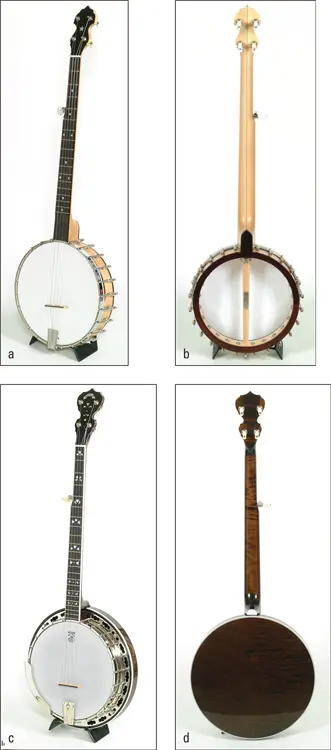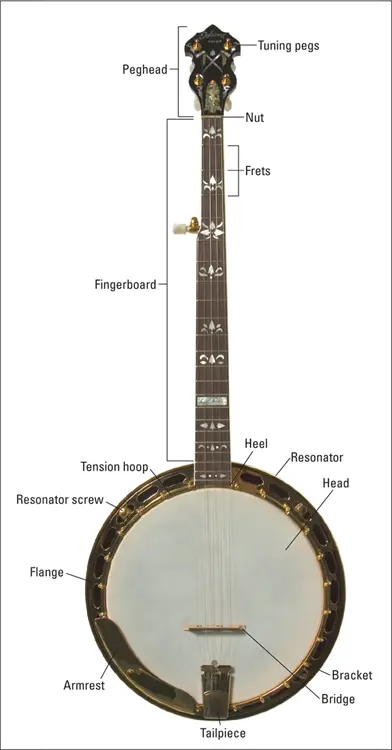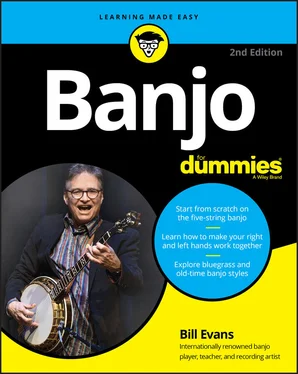Today, these more obscure branches of the banjo family tree are seen largely as novelty instruments and, like the tenor and plectrum banjo (see the section “ Tenor and plectrum banjos: Look for another book” in this chapter), are considered to be a different kind of instrument than a five-string banjo. Mandolin banjos are played like mandolins, and guitar banjos are played like guitars.
Knowing the Parts of a Banjo
The banjo combines wooden, metal, skin, and/or plastic parts held together by rods, nuts, screws, and brackets to make some of the most incredible and beautiful sounds in the world. You could call the banjo the Frankenstein of musical instruments, but I like to think of it as the Bionic Woman. Practically all banjos share a common characteristic of having a replaceable top playing surface made of plastic or animal skin (called the head ) that's stretched tightly across the body of the banjo (called the pot ) to form the top of the resonating body of the instrument (see Figure 1-3).
 Five-string banjos come in three different basic styles: open-back, resonator, and electric. Musicians select the kind of banjo they play based on their musical style and their personal tastes. Chapter 13explains the differences between these kinds of banjos, along with tips for making an informed purchase.
Five-string banjos come in three different basic styles: open-back, resonator, and electric. Musicians select the kind of banjo they play based on their musical style and their personal tastes. Chapter 13explains the differences between these kinds of banjos, along with tips for making an informed purchase.
In the following sections, you get to know the banjo from head to toe (well, really from the top of the headstock to the bottom of the pot). You also discover how the instrument captures the energy of a plucked string and turns it into that unmistakably great sound that banjo players love. You can refer to Figure 1-4 to see exactly where these parts are located on the banjo.

Photographs courtesy of Elderly Instruments
FIGURE 1-3:Comparing open-back (a and b) and resonator (c and d) five-string banjos

Photograph courtesy of Gruhn Guitars
FIGURE 1-4:The parts of a banjo.
The neck is one of the two main sections of the banjo (the pot being the other; see the section “ Checking out the pot”). The neck is the long piece of wood that supports the strings and tuners. Necks are usually made of maple, mahogany, or walnut.
To get a better feel for the banjo, take a look at the parts of the banjo neck:
Frets: The thin, metal bars on the banjo neck that are positioned at precise intervals to give you the various pitches needed when fretting a string. ( Fretting is what you do when you move a left-hand finger into position behind a fret to change the pitch of a string.) In the world of fretting, you use the term up the neck to refer to moving the left hand toward the pot and down the neck when you talk about moving the left hand toward the nut and peghead.
Fingerboard: A thin, flat, wooden strip glued to the neck that holds the frets and is the surface upon which the left hand produces notes and chords.
Peghead: Also called the headstock, the peghead is the elaborately shaped end of the neck that holds the tuning pegs for the four lower strings of the banjo.
Tuning pegs: Sometimes called tuners or tuning machines, these pegs are the devices that raise or lower the pitch of the banjo's strings with a turn of the buttons located on the backside of the peghead. The pegs for strings 1 through 4 are attached to the peghead, while the tuning peg for the 5th string is found on the topside of the neck near the 5th fret.
Nut: A block of ivory, bone, or plastic that's glued to the end of the fingerboard where the peghead begins. Strings 1 through 4 pass through the grooves in the nut on their way to the shafts of the tuning pegs. The 5th string has its own smaller nut, located near the 5th fret.
Heel: The name given to the part at the end of the neck that's attached to the pot of the banjo.
Truss rod: You can't see the truss rod, but it's an important part of most banjo necks. The truss rod is an adjustable metal rod that runs down most of the length of the banjo neck in a channel underneath the fingerboard. This rod helps to keep the neck stable and controls the amount of curve in the neck to keep the strings from buzzing when playing. Although some banjos don't have truss rods at all, most banjos have adjustable truss rods, which can be accessed at the peghead by removing the truss rod cover located just above the nut at the peghead. ( Note: This is a procedure best left to the pros.)
The other major section of the banjo (other than the neck; see the preceding section) is the pot, the round lower body of the banjo including all of its constituent parts. You can see some of the following parts highlighted in Figure 1-5:
Head: The head is the plastic or skin membrane that acts as the vibrating top of the banjo. The head is largely responsible for the unique sound of your new favorite instrument.
Rim: Sometimes called the shell, the rim is the circular wooden ring that is the centerpiece of the pot and is made from laminations or blocks of maple or mahogany. A well-made rim is essential to a good-sounding banjo.
Tone ring: This part of the pot is a metal circular collar that's machined to fit on top of the wooden rim, and the head is stretched tight across its top outer circumference. Tone rings come in a variety of shapes and sizes. Together with the rim, the tone ring provides the fundamental color of the banjo's tone. However, tone rings aren't found on all banjos and having one isn't absolutely necessary to having a good-sounding instrument.
Brackets: Sometimes called hooks, brackets are ringed around the banjo pot and are responsible for tightening the head via the bracket screws that are attached to each bracket on the underside of most banjos.
Tension hoop: Sometimes called the stretcher band, this circular metal ring fits over the outside edge of the banjo head and helps to uniformly stretch the head down across the top of the tone ring as the brackets are tightened.
Bridge: The bridge transmits the vibrations of the strings to the head. Bridges range in size from 5/8 inch to 3/4 inch. They are movable, but are held fast to the banjo head by the tension of the strings.
Tailpiece: This part holds the strings on the pot end of the banjo. Many tailpieces are adjustable in various ways that can subtly affect overall banjo tone.
Armrest: The armrest is attached to the pot of the banjo and extends over the top of the banjo head to make right-hand playing more comfortable while simultaneously protecting the head.
Coordinating rods: Seen only from the back of the banjo, these rods are attached at opposite ends of the rim, parallel to the banjo strings. The primary function of the coordinating rods is to keep the neck securely attached to the pot. However, they can also be used to make slight adjustments to the height of the strings off of the fingerboard (called string action ). Some banjos have only one coordinating rod, and many open-back banjos have what's called a dowel stick instead of a coordinating rod.
Resonator: The bowl-shaped piece of wood that's attached to many banjos, especially those used in bluegrass music, is the resonator. The resonator projects the sound out and away from the instrument. It's usually constructed from the same kind of wood as the banjo neck. Open-back banjos don't have resonators (see Chapter 13for more on the types of banjos).
Читать дальше

 Five-string banjos come in three different basic styles: open-back, resonator, and electric. Musicians select the kind of banjo they play based on their musical style and their personal tastes. Chapter 13explains the differences between these kinds of banjos, along with tips for making an informed purchase.
Five-string banjos come in three different basic styles: open-back, resonator, and electric. Musicians select the kind of banjo they play based on their musical style and their personal tastes. Chapter 13explains the differences between these kinds of banjos, along with tips for making an informed purchase.












